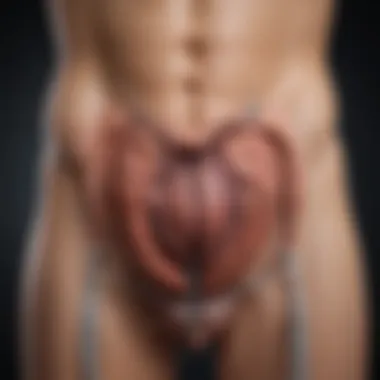Understanding Urinary Dripping After Urination


Intro
Urinary dripping post-micturition is a condition that many individuals experience, yet it often remains under-discussed in both medical and social contexts. This phenomenon can significantly affect physical comfort and personal hygiene, leading to potential embarrassment and complications for those affected. The pressing need to understand the underlying factors contributing to urinary dripping becomes evident when considering its potential impact on quality of life.
Recognizing that urinary leakage can stem from a range of physiological and anatomical issues is critical for proper management. It can be influenced by age, prostate health, pelvic floor strength, and even habitual patterns of urination. As professionals in health and wellness who encounter this issue in clients or patients, it is important to be informed about the causes and possible solutions.
This article will dissect the phenomenon of urinary dripping, offering insight into its prevalent causes while also outlining effective treatment options. The objective is not only to equip health professionals with knowledge but to enhance informed discussions about urinary health. Through this exploration, readers will gain a clearer understanding of how to address this common issue with sensitivity and comprehensiveness.
Prelims to Urinary Dripping
Understanding urinary dripping is essential for addressing an often overlooked yet prevalent issue. Post-micturition dripping can affect both men and women, impacting not only physical comfort but also overall hygiene and mental well-being. Recognizing this condition and its implications can lead to better management strategies and encourage individuals to seek appropriate care.
Defining Urinary Dripping
Urinary dripping refers to the involuntary leakage of urine that occurs after the act of urination is complete. This phenomenon can manifest as a few drops or a steady flow, affecting individuals during different times of the day. Often, it may happen when someone stands up or resumes regular activities immediately following urination. The condition can be embarrassing and may deter individuals from seeking help due to stigma.
Understanding urinary dripping requires an awareness of the anatomical and physiological components of urination. The urethra, as the conduit for urine expulsion, plays a central role. If the pelvic floor muscles are weakened or if there are anatomical anomalies, one may experience lingering urine despite having finished urinating.
Prevalence and Demographics
The prevalence of urinary dripping post-micturition can vary based on numerous factors, including age, sex, and health conditions. Studies suggest that approximately one in three older adults experience some form of urinary incontinence, with dripping being a subset of this broader category.
Several demographic variables influence the occurrence of urinary dripping.
- Gender: Men often relate it to prostate problems, while women may experience it related to childbirth or menopause.
- Age: There is a significant increase in urinary dripping as individuals age, with many elderly experiencing symptoms for the first time.
- Health Status: Underlying health issues, such as neurological disorders or diabetes, have been linked to higher instances of this condition.
Recognizing urinary dripping as a common issue, rather than an isolated problem, encourages affected individuals to pursue treatment and preventive measures.
Physiology of Urination
The physiology of urination is fundamental to understanding urinary dripping after micturition. This section explains how the urinary system functions normally and what can go wrong. A thorough comprehension of this process helps in identifying potential causes of the condition.
The Urinary Tract Anatomy
The urinary tract comprises several key structures that work together to produce, store, and eliminate urine. These include the kidneys, ureters, bladder, and urethra.
- Kidneys: These organs filter blood to produce urine. They eliminate waste and excess substances.
- Ureters: Muscular tubes transport urine from the kidneys to the bladder.
- Bladder: This is a storage reservoir for urine. It expands as it fills.
- Urethra: This tube allows urine to exit the body. In males, it is longer and also serves as a conduit for semen.
It is important for health professionals to understand the anatomy as variations or abnormalities can influence urinary function. Anatomical variations can result in inadequate urine expulsion, potentially leading to urinary dripping.
Micturition Process
Micturition, or urination, is a complex process involving both voluntary and involuntary actions. The process starts when the bladder fills with urine. When it reaches a certain capacity, stretch receptors in the bladder wall activate and signal the brain.
This leads to:
- Bladder contraction: The detrusor muscle contracts, pushing urine into the urethra.
- Sphincter control: The internal and external sphincters relax, allowing urine to flow out.
This coordination is vital for normal urination. Disruption in the process can result in post-micturition dripping. Factors like weakened pelvic muscles, neurological disorders, or previous surgery can affect this intricate system.
Understanding the anatomy and micturition process provides insights into the mechanics of urinary dripping, aiding in targeted assessment and management for individuals dealing with this condition.
"Anatomical knowledge is crucial for health professionals diagnosing urinary issues accurately."
By grasping the physiology behind urination, healthcare providers can engage in detailed discussions with patients and recommend appropriate interventions if necessary.
Causes of Post-Micturition Dripping


Understanding the causes of post-micturition dripping is crucial for effectively addressing the condition. This phenomenon occurs when there is involuntary leakage of urine after finishing urination, which can lead to discomfort and concerns regarding personal hygiene. By identifying the specific causes contributing to this issue, individuals can pursue appropriate management strategies and facilitate discussions with healthcare providers on effective remedies.
Anatomical Factors
Anatomical factors play a vital role in urinary dripping. The arrangement and function of the urinary tract, specifically in males and females, differ significantly. In men, the prostate gland surrounds the urethra. As men age, the prostate may enlarge and obstruct the flow of urine, leading to incomplete bladder emptying and subsequent dripping. In females, the position of the urethra and pelvic anatomy can contribute to urinary control issues. Factors such as childbirth can weaken pelvic floor muscles, resulting in structural changes. These anatomical variations are essential in understanding how they might lead to post-micturition leakage.
Physiological Conditions
Several physiological conditions can also contribute to urinary dripping. Conditions such as overactive bladder, urinary tract infections, and prostate conditions can directly affect urinary function. An overactive bladder may cause a sudden urge to urinate, leading to incomplete urination and subsequent dripping. Urinary tract infections can irritate the bladder, causing frequent urination and potentially leading to dribbling after emptying. Prostatitis, or inflammation of the prostate, may also cause difficulties in controlling urination. Identifying these underlying physiological conditions is necessary for guiding treatment options.
Age-Related Changes
Age-related changes are common factors influencing post-micturition dripping. As people age, their bodies undergo various modifications that affect bladder control. For instance, muscle tone in the pelvic floor may weaken, reducing the support to the bladder and urethra. Additionally, nerve changes can diminish the responsiveness of the bladder, making it less efficient in expelling urine completely. Hormonal changes also impact urinary functioning, particularly in women post-menopause, leading to an increased chance of leakage. Recognizing these age-related factors is important in engaging in proactive health measures to manage or prevent urinary dripping.
Monitoring these causes and their interplay is crucial for management and interventions.
Understanding the multifaceted causes of post-micturition dripping empowers individuals and healthcare professionals alike. By focusing on specific anatomical, physiological, and age-related factors, it becomes possible to tailor treatment and preventive strategies effectively.
Risk Factors Associated with Urinary Dripping
Understanding the risk factors associated with urinary dripping is critical. This understanding can lead to better management and prevention of the condition. Knowing these factors allows healthcare professionals to identify patients at higher risk. Personalized treatment plans become more effective when specific risk factors are considered. The following sections detail three prominent risk factors: previous surgical history, neurological conditions, and lifestyle factors.
Previous Surgical History
Surgical history can play a significant role in urinary function. Patients who have undergone surgery in the pelvic area may experience complications. Common surgeries include prostate surgery in men and hysterectomy in women.
These procedures can affect the nerves and muscles that control urination. Sometimes, surgeries can lead to scarring or repositioning of anatomical structures. This can disrupt the normal flow and retention of urine, increasing the risk of post-micturition dripping. Furthermore, surgical techniques and post-operative recovery play essential roles in urinary health.
Neurological Conditions
Neurological conditions greatly influence urinary function. Diseases like multiple sclerosis, Parkinson's disease, and stroke impact nerve signals that govern bladder control. When the nervous system is compromised, signal transmission becomes irregular. This can lead to involuntary leakage or delayed urination, causing dripping after urination.
Current research shows that individuals with such neurological disorders experience higher rates of urinary incontinence. Awareness of these conditions is vital for clinicians managing patients with urinary dripping.
Lifestyle Factors
Certain lifestyle choices can exacerbate urinary dripping. Obesity, for instance, increases intra-abdominal pressure. This can overwhelm the bladder's ability to retain urine, leading to dribbling after voiding. Similarly, high caffeine and alcohol intake irritate the bladder, resulting in increased urgency and frequency of urination.
Incorporating pelvic floor exercises into daily routines can mitigate some risks. Exercise enhances muscle strength in the pelvic region. There is also evidence that encourages smoking cessation as smoking can worsen cough-related leakage, compounding the problem. It is essential for healthcare providers to assess lifestyle factors to provide tailored advice to patients.
Diagnosis of Urinary Dripping
Diagnosing urinary dripping post-micturition is crucial for identifying the underlying causes and implementing appropriate treatment plans. Accurate diagnosis facilitates a clear understanding of the condition and its implications on the patient’s lifestyle. Moreover, understanding the specifics of urinary dripping allows healthcare professionals to tailor their approaches, ensuring better outcomes for individuals affected by this issue.
The process of diagnosing urinary dripping often begins with a comprehensive clinical evaluation, followed by necessary diagnostic tests. Each step holds significance, contributing to a well-rounded understanding of the patient's specific circumstances.
Clinical Evaluation
The clinical evaluation serves as the first point of contact between the healthcare provider and the patient. During this stage, practitioners gather detailed information about the patient’s medical history and symptomatology. This can include:
- Frequency and severity of dripping events
- Timing of occurrence in relation to urination
- Associated symptoms, such as urgency or straining
- Any previous interventions or treatments attempted
Through direct questioning and observation, healthcare professionals can better assess the condition's impact on the patient's life. It is vital to create an empathetic atmosphere where patients feel comfortable sharing personal details about their experiences. This evaluation not only focuses on the physical symptoms but also incorporates emotional and psychological aspects related to urinary health.
Diagnostic Tests
After the clinical evaluation, various diagnostic tests may be recommended to further investigate the causes of urinary dripping. These tests can range from simple to complex, depending on the initial findings. Common diagnostic approaches include:
- Urinalysis: A basic test to check for infections or abnormalities in urine composition.
- Post-Void Residual Measurement: This involves measuring the amount of urine left in the bladder after urination, indicating possible obstruction or incomplete voiding.
- Urodynamic Testing: A series of tests that assess the bladder's functionality and dynamics during filling and emptying.
- Cystoscopy: A procedure that allows direct visualization of the bladder's interior utilizing a thin tube equipped with a camera.
- Imaging studies: Techniques such as ultrasound or MRI may be employed to observe structural issues within the urinary tract.


Each test plays a specific role in illustrating a clearer picture of the urinary system's condition. Effective diagnosis hinges on integrating the findings from both clinical evaluations and diagnostic tests, leading to more informed treatment options.
This thorough diagnostic approach ensures individuals receive the understanding and care they need to address urinary dripping effectively. With proper diagnosis, patients are empowered to engage in informed discussions with their healthcare providers, fostering proactive management of their condition.
Treatment Options for Urinary Dripping
When addressing urinary dripping post-micturition, it is essential to consider various treatment options available for effective management. This condition can lead to discomfort and affect the overall quality of life for many individuals. Understanding the treatment options not only aids in alleviating symptoms but also provides a structured approach to tackling the underlying causes.
Implementing the right treatment strategy depends on various factors, including the individual's specific condition, the severity of leakage, and their overall health. The options include conservative strategies, pharmacological treatments, and surgical interventions. Each method has its unique benefits and considerations that deserve attention.
Conservative Management
Conservative management typically serves as the first line of defense against urinary dripping. This approach involves non-invasive strategies aimed at improving bladder control and reducing leakage without immediate medical intervention.
Common conservative methods include:
- Pelvic Floor Exercises: Also known as Kegel exercises, these strengthen the pelvic floor and improve muscle tone, helping reduce leakage.
- Bladder Training: This method encourages patients to gradually increase the time between urination, allowing the bladder to improve its capacity.
- Fluid Management: Adjusting fluid intake patterns can help control the urge and frequency of urination.
The benefits of conservative management are numerous. It promotes self-efficacy and encourages individuals to take proactive steps in managing their condition. Furthermore, since it is less invasive, patients often experience fewer side effects compared to pharmaceutical approaches.
Pharmacological Treatments
If conservative management does not yield the desired results, healthcare providers may consider pharmacological treatments. These involve medications designed to help improve bladder function.
Some commonly used medications for urinary dripping include:
- Anticholinergics: These drugs help to decrease involuntary bladder contractions, thus reducing urgency.
- Beta-3 Agonists: They relax the bladder muscle, improving its storage capabilities.
- Topical Estrogen: This is particularly useful in postmenopausal women, as it can help rejuvenate urethral tissue, improving function.
Pharmacological treatments can be effective but require careful consideration. Side effects can occur, and the potential for drug interactions needs monitoring.
Surgical Interventions
In cases where conservative management and pharmacological treatments fail, surgical interventions may be recommended. Surgical options provide a more permanent solution to the complexity of urinary dripping.
Types of surgical interventions may include:
- Sling Procedures: These involve placing a tape or mesh under the urethra to provide support and prevent leakage during movement or exertion.
- Bulking Agents: In this procedure, substances are injected into the tissue around the urethra to provide added support, enhancing closure.
- Prostate Procedures: For men, certain surgeries targeting the prostate may relieve associated urinary constraints.
Surgery carries inherent risks and requires thorough discussion between the patient and healthcare team. Evaluations are essential to determine if surgical options are appropriate based on individual health status and severity of the condition.
In summary, a spectrum of treatment options is available for managing urinary dripping. From preventive exercises to surgical solutions, each choice is tailored to meet patient needs while considering their specific circumstances. Ensuring effective communication about these options with healthcare providers is crucial for optimal outcomes.
Preventative Strategies
Pelvic Floor Exercises
Pelvic floor exercises are a cornerstone in the prevention of urinary dripping. These exercises strengthen the pelvic floor muscles, which play an important role in bladder control. One popular method is Kegel exercises. They are simple yet effective, requiring individuals to contract and relax the pelvic muscles. Regular practice can lead to noticeable improvements in bladder stability.
The benefits of pelvic floor exercises include:
- Increased muscle tone and strength
- Enhanced control during urination
- Decreased likelihood of post-micturition dripping
Behavioral Modifications
In addition to physical exercises, behavioral modifications are critical for managing urinary dripping. These strategies can involve simple lifestyle changes that focus on urination habits and dietary adjustments. Some practical behavioral modifications include:
- Establishing a regular urination schedule to empty the bladder consistently.
- Avoiding excessive fluid intake before activities where leakage might occur.
- Noting any triggers that lead to urinary dripping, such as certain foods or beverages.
Adopting these changes can lead to significant shifts in urinary health. Attention to timing and cues from the body can promote better control and reduce the distress associated with urinary dripping.


The combination of pelvic floor exercises and behavioral modifications can notably aid in reducing the occurrence of urinary dripping and enhance personal health management practices.
Through thoughtful implementation of these strategies, individuals can achieve better control over their urinary health. Addressing these aspects can create a proactive environment for managing and potentially preventing urinary dripping.
Impact on Quality of Life
Urinary dripping post-micturition can significantly affect an individual's quality of life. This issue may not just be a physical discomfort; it often extends into emotional and social dimensions. The implications of this condition are wide-ranging and can interfere with daily activities, personal interactions, and overall well-being.
Emotional and Psychological Effects
The emotional toll of urinary dripping can be profound. Individuals may experience feelings of embarrassment or shame due to unexpected leaks. These emotions can lead to anxiety, a diminished self-esteem, or even depression. The constant worry about potential leakage can make social situations stressful, preventing individuals from fully engaging in communal activities. Over time, this can result in withdrawal from social settings, fostering feelings of isolation.
Understanding these psychological effects is important for healthcare providers. They must recognize that urinary dripping is not solely a physical issue but can also have a significant emotional component. Addressing both aspects in treatment approaches is essential for an effective management strategy.
Social Implications
The social impact of urinary dripping can manifest in various ways. For many, the fear of leakage can lead to avoiding gatherings, whether social, professional, or familial. This avoidance can hinder relationships and create a barrier to engaging in activities that once brought joy. Additionally, individuals may feel uncomfortable discussing their condition, leading to a lack of support and understanding from peers.
Moreover, urinary dripping can affect professional life. Individuals may hesitate to pursue opportunities that require travel or long hours in a meeting, fearing embarrassment. This situation can impact career progression and job satisfaction.
To mitigate these social implications, open communication is critical. Encouraging conversations about urinary health can destigmatize the condition. Moreover, support groups or counseling can create a safe space for individuals to share their experiences and find comfort in community.
In summary, understanding the multi-faceted impact of urinary dripping is essential. It underscores the importance of approaching treatment holistically, considering not just the physical, but also the emotional and social dimensions. Recognizing this can lead to better patient outcomes and enhanced quality of life.
Communicating with Healthcare Providers
Effective communication with healthcare providers is crucial for managing urinary dripping post-micturition. These conversations can shape the trajectory of treatment and often lead to improved health outcomes. To address urinary issues adequately, patients must convey their concerns clearly and comprehensively. On the other hand, healthcare providers benefit from understanding the patient’s perspective and experiences. This mutual exchange is essential for establishing a trusting relationship and for the patient to feel heard.
Additionally, discussing urinary symptoms openly can demystify this often-stigmatized topic. It can encourage others who experience similar issues to seek help, fostering a more supportive environment. Talking about urinary dripping reduces the shame that often surrounds bladder issues and promotes a proactive stance towards health.
In preparing to share their experiences, patients should consider several elements. They should evaluate the intensity and frequency of symptoms, and any triggers that may exacerbate their situation. This detailed information can assist the healthcare provider in diagnosing the underlying causes effectively, and proposing a treatment plan tailored to the patient’s needs.
Preparing for Appointments
Preparation for medical appointments can significantly enhance the outcome of discussions about urinary dripping. Patients should start by documenting their symptoms. Keeping a diary of occurrences and patterns can offer insights that may not be immediately apparent. It's helpful to note:
- Frequency of dripping episodes
- Any correlations with fluid intake or dietary choices
- Physical activities that might trigger symptoms
- Emotional or psychological states at those times
This record can serve as a valuable reference during consultations, providing clear evidence for the healthcare provider. Besides symptom tracking, patients should also gather their medical history. A thorough overview of previous medical conditions, medications, and surgeries can provide context that may influence current urinary health.
Furthermore, it’s advisable to compile a list of concerns and questions to ensure that important topics are not overlooked during the appointment. Being succinct while being thorough can create a more efficient discussion.
Key Questions to Ask
During the consultation, patients should feel empowered to ask questions. Health professionals appreciate when patients take an active role in their health management. Key questions might include:
- What are the potential underlying causes of my urinary dripping?
- What tests or evaluations would you recommend?
- Are there specific treatments or lifestyle modifications that can alleviate my symptoms?
- What are the possible side effects or risks associated with the proposed treatments?
- How will we determine if the treatment is effective?
- What future steps can be taken if the initial treatment does not yield improvement?
Each of these inquiries can elicit important information about managing urinary dripping post-micturition effectively. Furthermore, returning to the appointment after receiving initial recommendations allows patients to gauge their comfort level and concerns effectively.
Clear communication with healthcare providers can significantly improve management of urinary issues, leading to better overall health outcomes.
In summary, understanding how to communicate effectively with healthcare providers about urinary dripping can empower patients. It can lead to timely interventions and improve overall quality of life.
Culmination
The discussion about urinary dripping post-micturition is vital for understanding the complexities surrounding urinary health. This part of the article aims to consolidate the information presented earlier. It highlights the importance of recognizing urinary dripping not just as a mere inconvenience but as a condition that can significantly impact an individual’s quality of life.
In focusing on the summary of key points, it is crucial to revisit the physiological, anatomical, and psychological aspects discussed throughout the previous sections. These factors contribute to the occurrence of urinary dripping. Understanding them prepares patients for meaningful discussions with healthcare providers.
Furthermore, the encouragement for seeking help should resonate strongly. Many individuals experience urinary dripping, yet they may remain silent due to shame or embarrassment. These barriers must be addressed openly. Professional guidance can lead to effective treatment options and a better quality of life, emphasizing that nobody should feel alone in their experiences with urinary leaking.
"Seeking help is the first step toward effective management and improved well-being."
This conclusion serves to empower individuals to take action about their health and to prioritize their comfort and hygiene. Approaching healthcare conversations with the insights gained from this article can foster a proactive stance in managing urinary health issues.







